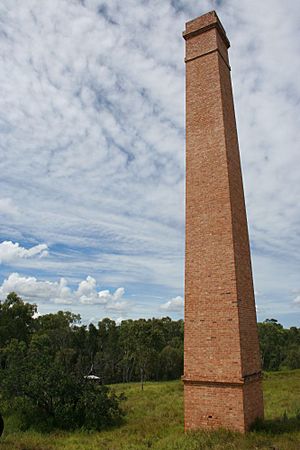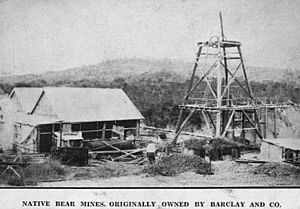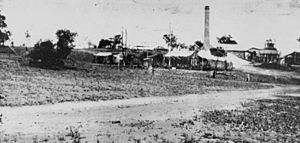Barclay's Battery facts for kids
Quick facts for kids Barclay's Battery |
|
|---|---|

Chimney, Barclay's Battery
|
|
| Location | Collinsville road, Mount Coolon, Whitsunday Region, Queensland, Australia |
| Design period | 1914 - 1919 (World War I) |
| Built | 1914 - 1932 |
| Official name: Barclay's Battery, Mount Coolon Gold Mines Battery | |
| Type | state heritage (archaeological, built) |
| Designated | 17 May 2004 |
| Reference no. | 602242 |
| Significant period | 1914-1932 (fabric) 1914-1941, 1918, 1935 (historical) |
| Significant components | mounting block/stand, residential accommodation - housing, chimney/chimney stack, weir, vat, machinery/plant/equipment - mining/mineral processing |
| Lua error in Module:Location_map at line 420: attempt to index field 'wikibase' (a nil value). | |
Barclay's Battery is a special historical site near Mount Coolon in Queensland, Australia. It's a type of old factory called a stamper battery that was used to crush rocks to find gold. It was built between 1914 and 1932. This site is also known as the Mount Coolon Gold Mines Battery. It's so important that it was added to the Queensland Heritage Register on 17 May 2004.
Contents
Discovering Gold at Mount Coolon
Mount Coolon is about 130 kilometers (80 miles) southwest of Collinsville. In 1913, a young trainee farmer, called a jackaroo, named Luke Reynolds found gold there. Soon after, in 1914, Thomas Coolon was the first to claim land for mining. Many others followed, including an active gold seeker named James Barclay.
James Barclay's Gold Mine
James Barclay started mining gold at a place he called the Native Bear lease in 1914. He built a small gold-crushing machine, called a 5-head battery, near Police Creek. This was about 2.4 kilometers (1.5 miles) from his mine.
In 1917, other mine owners put up a bigger 10-stamp battery nearby. Barclay then combined his claims to form the Native Bear lease, which had the most valuable gold. That same year, Barclay added more machines to his battery. He put in another 15 stamps, two large boilers, and an assay plant to test the gold. He also built a furnace for melting gold and a tall 23-meter (75-foot) chimney. This chimney was made from 200,000 bricks found locally. By 1918, Barclay was also using a cyanide plant to get even more gold from the crushed rock.
Growth of the Goldfield
In 1917, a town called Koala was planned near Police Creek. This town is now known as Mount Coolon.
By 1921, over 2,100 ounces of gold were found in the area. By 1922, there were 12 different mining claims on the Mount Coolon gold vein. Most of the gold came from Barclay's Native Bear lease. His battery worked two shifts a day, crushing about 7 to 8 tons of rock per shift. In 1921, Barclay's battery crushed 2,546 tons of rock, which produced 1,707 ounces of gold. They also treated 400 tons of waste rock with cyanide, getting another 425 ounces of gold. All this gold was worth over £7,000! In 1922, Barclay added another 10 stamps to his battery.
The goldfield grew slowly because there wasn't a public battery for everyone to use. So, in 1924, a new type of crushing machine called an Empire ball mill was built near Barclay's battery. Barclay also put in a powerful gas engine to run all his machines, replacing the old steam power. This meant there were three working gold mills on Police Creek.
By June 1932, a company called Mount Coolon Gold Mines had bought all the mines and batteries in the area. They also built a new dam on Police Creek, which is still there today.
A Big Strike in 1935
In 1932, Mount Coolon produced the most gold in Queensland. The Mount Coolon Gold Mines Company, which had bought Barclay's operations, built a huge new plant to process gold about 2.3 kilometers (1.4 miles) south of the town.
In 1935, something very important happened at Mount Coolon. Workers at the mine went on strike for six months. This was a big event in Queensland's history of workers' rights. It showed how hard life could be for miners in isolated, dry areas. The strike also highlighted how workers, their unions, and mine owners dealt with disagreements. Even though only about 100 workers were involved, it was a very difficult time. The hot, dry weather and a severe drought in 1934-35 made things even tougher.
In the late 1930s, the Mount Coolon goldfield was very profitable for its owner, Gold Mines of Australia. This success helped start a huge mining company called Western Mining Corporation. However, by 1941, most miners had left the area, selling their machines and giving up their claims.
Later, in 1947, people started looking for gold and another mineral called bismuth again. New equipment was brought in to process gold found in riverbeds.
What You Can See Today
The Barclay's Battery site stretches from the northern edge of Mount Coolon town along Police Creek. It includes a weir (a small dam) and the site of an old house.
At the main mill site, you can still see:
- A square brick chimney.
- Concrete foundations where a 10-head stamp battery once stood.
- Two large metal boxes called mortar boxes, which held the rocks to be crushed.
- Parts of old engines, including a gas producer and a two-cylinder gas engine.
- A one-cylinder Crossley engine.
- A ball mill, another type of crushing machine.
- A large steel vat.
Closer to the Mount Coolon Hotel, you can find the timber, stone, and concrete foundations of the old cyanide plant.
The machinery that remains includes:
- A one-cylinder gas engine with a flywheel, made by Crossley Brothers Limited Manchester (part of the engine block is missing).
- A mortar box made by Hudson Brothers Engineers Clyde N.S.W. in 1897.
- Another mortar box made by Walkers Limited.
- Parts of a two-cylinder gas engine and its flywheel.
- A ball mill.
- A gas producer.
Why is Barclay's Battery Important?
Barclay's Battery was listed on the Queensland Heritage Register on 17 May 2004 because it meets several important criteria.
Showing Queensland's History
This site helps us understand how the gold mining industry grew and changed in North Queensland. It shows how mines started, got bigger, were sometimes taken over by larger companies, and eventually closed down. This happened at Mount Coolon when it became too isolated to keep mining.
Rare and Special Features
The battery site has a brick chimney, a ball mill, parts of a stamp mill, and a rare type of gas engine. These parts show us the different kinds of machines used in gold mining operations at Mount Coolon.
Connection to the Community
Barclay's Battery is strongly linked to the mining community of Mount Coolon. It's also connected to important historical events in Queensland. The mining operations here are significant because of the six-month strike in 1935. This strike showed the many challenges and difficulties faced by people working in isolated, dry mining areas.



